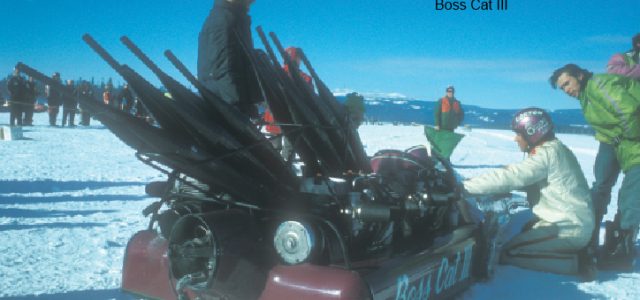
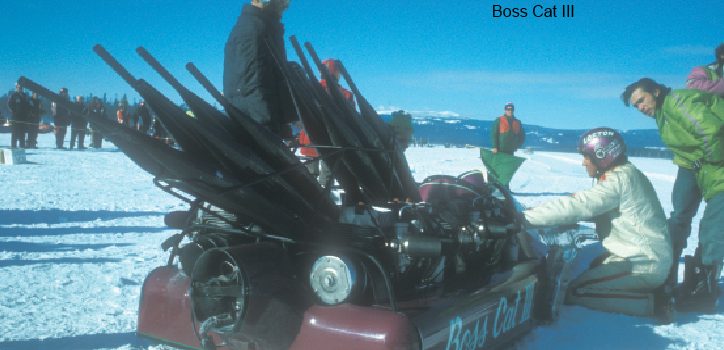
The Chase for a Snowmobile World Speed Record: A Short History

By Hal Armstrong
Who is the fastest? Whether it’s the 100m run at the Olympics, NHRA top fuel record or the Land Speed Record we are all still captivated by these words whenever we hear them. Break a world record and you get recognition by the media that even the best advertising campaign is hard pressed to achieve. To own the title “World Snowmobile Speed Record” and use some of the same components found on a consumer sled was a marketing managers dream come true!
For many years West Yellowstone, Montana was the location of the last “big” race of the season in North America. The “Round-Up” as it was called was not only the end of the season, but also a chance to test new engines, suspensions and clutching that were kept under wraps in last year’s snowmobile body work. As Ted Otto (famous flagman and former Polaris Marketing Manager in the early 70’s) explained, “Yellowstone became a measuring point for the season to come, not the season behind.”
The goal for all the manufacturers initially was to break the 100 mph barrier. As everyone who has been around snowmobiles long enough, running a snowmobile at this speed even today takes a lot of horsepower, hard pack flat surface and no head wind. Most importantly is to have a radar gun or a GPS to measure your true ground speed. Snowmobile speedometers, even today, are not the most accurate. Sled makers long ago learned the easiest way to make a sled go faster was to make the speedometer say so.
Where it began
The annual speed run was a chance for each factory to bring their latest “one-off” creation to showcase their engineering prowess. It really was a battle between Arctic Cat, Polaris and Ski-Doo over the years, but other manufacturers of the day as well as some independents built sleds hoping to reach the magic mark. How it all started is quite simple – when the second snowmobile was built, the first race was held. The first “official” speed run using sophisticated timing lights was held at West Yellowstone at the old airport back in 1967 when Bob Eastman set the mark at 73.9 mph riding a 744cc JLO powered Polaris.
The following year Gerry Reese set the record at 83 mph on a Polaris that featured two 744cc motors. Little publicity was given to these records but in 1969 when snowmobile sales were rising exponentially, all the manufacturers were claiming more oval track victories than the next. A win at the Yellowstone Speed runs was indisputable. Top speed wins. Period!

1969 …… Fly like a Double Eagle
Ski-Doo had decided enough was enough. The factory built 24 twin-engine sleds at the race shop. The machine was called the “Double Eagle”. The sleds were built on a stock 1969 T’NT with an 18” wide track. The engines were Rotax 399cc twin cylinder fan cooled motors. The front engine ran in reverse rotation and the second engine was located conventially for the day, sitting on top of the tunnel in front of the driver. Both engines supplied power through a belt driven secondary that drove a chain case. The drive axle had a chain case on either side to supply power to the track. Why 399cc motors? Well 2 x 399 = 798cc which allowed these sleds to also compete in the 800cc oval class. In addition to the 21 (twin 399) sleds, Ski-Doo also built three sleds with twin 699cc fan cooled Rotax engines. One of these sleds made it to the hands of Duane Eck, a hotshot racer from Driggs, Idaho. The sled featured what is believed to be the first set of tuned expansion chambers on a two-stroke powered snowmobile. All other sleds were running megaphone exhaust systems that improved performance but nothing like a properly designed expansion chamber. The Double Eagle that broke the speed record in 1969 was running around 130hp in total from the two engines. This was huge power for the day and the result was a speed of 95.33 mph!
Ski-Doo headed into the 1970 season as the #1 selling brand and with the World Speed Record to boot!
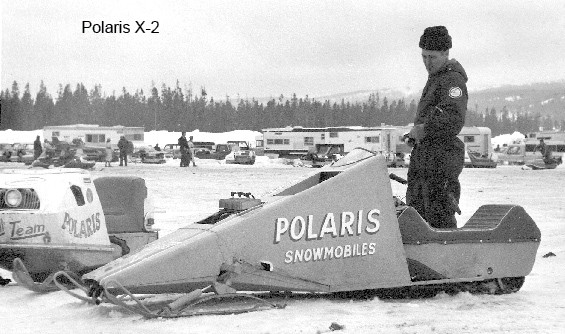
1970 – The Flying Wedge
When the big three gathered once again in West Yellowstone in March of 1970, the speed sleds kept under wraps all season were unveiled only minutes prior to making their run down the airport runway strip. Many unique sleds were brought this year that raised questions as to what the definition of a snowmobile was. Ski-Doo’s Duane Eck was the defending champ and was given the first run down the track. Ski-Doo ran the year-old Double Eagle chassis with two 771cc free-air Rotax Blizzard engines, but never crossed the timing lights due to a blown piston. Next was Gaston Ferland from Quebec on the 2nd factory Double Eagle Ski-Doo and his speed went down in history as the first person to officially break the 100 mph mark (100.22). Ski-Doo had raised the bar again!
Team Arctic was up next and they had brought their original (pre-dragster) Boss Cat to Yellowstone. It featured two three-cylinder JLO engines. It had a 6-megaphone exhaust and took 5 men to start it. The engines were chain driven directly from the crankshaft to the track drive. When the engines were pulled over to start, the track would turn with the engine. So to start it the rear of the sled was lifted off the ground until the engines fired to life. With no clutch the sled was slow to get moving and slowly gained speed. The idea here was to maximize the power to the track and eliminate the issue of blowing belts that was all too common with high hp sleds. The Boss Cat broke the timing lights @ 102.5 mph.
Next up was the 1st purpose-built speed machine, the Polaris X2 “Flying Wedge”. The sled featured two 795cc 3-cylinder engines that used the new aluminum flyweight clutch. Power to the track drive sprockets was through a pair of chaincase-mounted secondary clutches to drive a 15” cleated track. The hood was a first attempt at cheating the wind by building a seat of the pants aerodynamic wedge to reduce drag. The design worked as the X-2 hit 109.9 mph. It was followed up by Polaris Factory rider Dorothy Mercer who broke the woman’s record reaching 107.1 mph. The Polaris team had claimed the world record prize capping off a winning season.
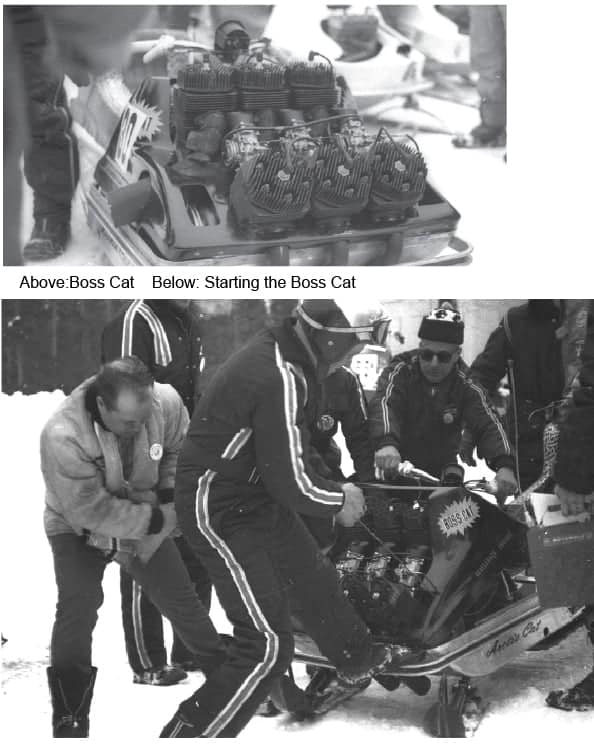
1971 – The Year of the Cat
1971 was the year of 100% purpose built speed machines. The quest to break 100 mph had been achieved, and now the gloves were off. Arctic Cat in particular introduced the (dragster-style) Boss Cat I, Ski-Doo built three sleds (a new Double Eagle, X2R and the 12 cylinder X-4R). Polaris returned with the X2 and a revised design called the X3.
The success of the West Yellowstone speed runs set the stage for Boonville, New York to host the first sanctioned USSA speed run followed by a 2nd event at Coon Rapids, Minnesota and the final at West Yellowstone.
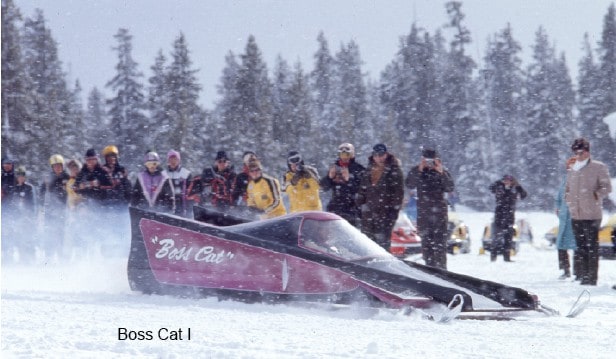
Arctic introduced the Boss Cat I at Boonville on Feb.12th, 1971. Arctic had spent 8 months designing and building the sled at a cost of $30K. The sled was 20’ long and was powered by a Turbonique turbine engine capable of putting out 400-1000hp. The power was transferred from the turbine output shaft to a jackshaft that was chain driven to a 28” wide x 11 ft long rubber track. Many of the manufacturers complained that this machine was not a snowmobile, as it was not powered by conventional snowmobile engine.
Polaris returned with the X-2 speed sled with some minor revisions. The X-2 ran 118.11 mph at Boonville, New York setting a new world record. The Polaris sled was the only machine that held together down the 1-mile track. The new Boss Cat and Ski-Doo speed sleds suffered mechanical gremlins all weekend.
At the 2nd round in Minnesota, the new Boss Cat I driven by Dale Cormican blew down the mile track at 125.87 mph to set yet another new world speed record.
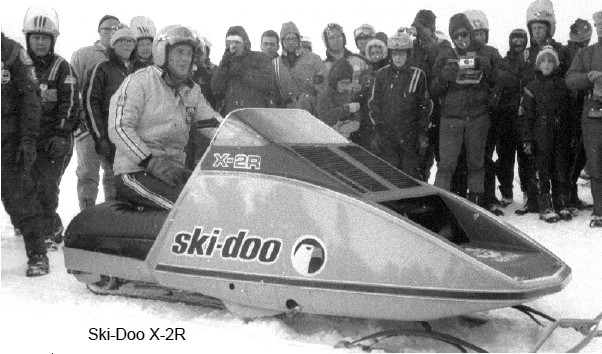
Ski-Doo returned to the speed wars with no less than three new speed sleds. A revised Double Eagle was now equipped with two massive Rotax 797cc free air triples. Ski-Doo also built their version of the Polaris X-2 and called it the X-2R. This sled featured direct drive with the secondary clutches mounted on either side of the track drive axle.
The X-2R best speed was 111.54 mph set at the Minnesota track. Ski-Doo was having lots of trouble keeping the sled together on the weekend with the track drive axle causing lots of problems.
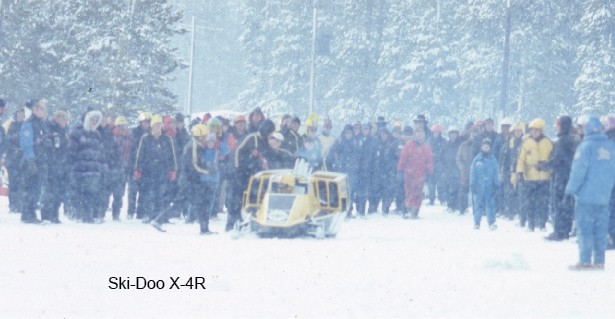
The X-4R is one of the most unique race sleds built. Ski-Doo had installed four (797cc) triples with triple pipes exiting straight-up into the air. It resembled a Formula 1 race car with the engines mounted behind the cockpit and two tracks put the power to the snow. The front ski suspension was an A-arm design that was not used on a production or race sled until the 1984 twin track race sleds appeared. The X-4R engines in combination produced over 400 hp. At Coon Rapids, the Ski-Doo race team managed a 123.43 mph on the day. Cat had set the record and Round 3 would determine if the record would stand.
The circus hit the road for Yellowstone. The speeds that year were well below the 1970 records. A snowstorm the night before the event buried the track, forcing the event to be held not on hardpack, but deep fluffy snow.

Polaris brought their answer to the Boss Cat, a new speed sled called the X-3 which featured improved aerodynamics that had the driver lie flat on his stomach and the engines tipped 90 degrees to lower the machine center of gravity. Mike Baker from Polaris ran the sled to a top speed of 93 mph. Ski-Doo ran their sleds, but they too ran well below 100 mph. The Boss Cat I reached 108.69 mph. It was a disappointing end to a year that wet the appetite of Arctic Cat and Ski-Doo entering the ’72 race season.
1972 – Speed Runs Heat Up
The Boonville, NY speed run held Feb.11th, 1972 would go down as the most spectacular event of the 70’s. A Chevy 327 punched out to 375 cubic inches powered the Boss Cat II. The engine was supercharged and ran on alcohol with an estimated 650 to 700 HP. Power to the snow was via two 20 1/2 “wide tracks. The sled was really built like a dragster. The shear size of this sled was intimidating @ 23’ long, 6’ wide and just 30 inches high, but weighed 2300 lbs. Denny Ray of Arctic Cat, who built and designed the Boss Cat I, was serious about his speed sleds.
Charlie Lofton ran the sled at 130.2 mph down the 1.4 mile strip before a fire started from a broken fuel hose. The rules of the event this year required two back-to-back runs with the average speed recorded as the official speed. The new Cat was disqualified as it failed to make a second run after the fire that day. Cat would be back later in the year.
The Boss Cat I started its run down the track when the turbine engine exploded and the sled caught fire. Driver Dale Cormican was taken to hospital with injuries. He never ran another speed sled again and the USSA promptly banned all turbine/rocket powered sleds in the future.
Polaris brought their new X-3 but boycotted the race, as they did not agree with the rules allowing turbines, rockets or automotive engines as power plants. Polaris believed only snowmobile engines should be used to break the record.

Ski-Doo was hungry to regain the title and they brought two new sleds to Boonville – a revised X-2R with two (797cc) triple/triples. The sled featured revised styling, 200 plus hp and Yvon Duhamel was behind the handlebars. The first run of the 1.4 mile course was timed at 129.3 mph and he backed it up with a 125.4 mph 2nd run for an average speed of 127.3 mph – a new world speed record.

Ski-Doo also brought the last speed machine they would build which was called the “Inferno”. The machine looked like a dragster and had two 797cc triple engines. The front engine was mounted in front of the driver and the second engine was located behind the driver. The front engine drove the front drive shaft of the track like a conventional sled and the rear engine drove the rear track drive axle. In effect a “push/pull” drive arrangement. In both cases the secondary clutch was mounted directly to the drive axle. Gaston Ferland lined the new sled up and nailed the throttle. The track let go and ripped to shreds. The engineers packed the sled up and headed back to Valcourt to work the “bugs” out.

Arctic Cat brought the Boss Cat II to the home of Polaris in Roseau, Minnesota later in the winter and hit 131.58 mph. In March 1972 at the “Roundup “ in Yellowstone Charlie Lofton from Team Arctic drove the sled to a speed of 123 mph before it caught fire again. The USSA snowmobile sanctioning body did not recognize any of the Boss Cat II speed records. The dispute as to who held the record between Arctic Cat and Ski-Doo continued un-resolved heading into the final speed season waged by the manufacturers.
1973 – The End of the Go-Fast Club
The 3nd annual USSA sanctioned Boonville, NY Speed runs was run Feb.9th, 1973. Polaris returned with a brand new sled called the “Shooting Star”. It was styled after the ‘73 Starfire oval race sled that Bob Eastman had just driven to the Eagle River World Championship. The Shooting Star had two 800cc triple-triple engines. The sled would feature a number of features that would appear on the ‘74 SnoPro sleds, primarily a magnesium chassis. The sled posted a 124 mph speed, but on the second run mechanical problems developed and the team did not have the parts to repair it.


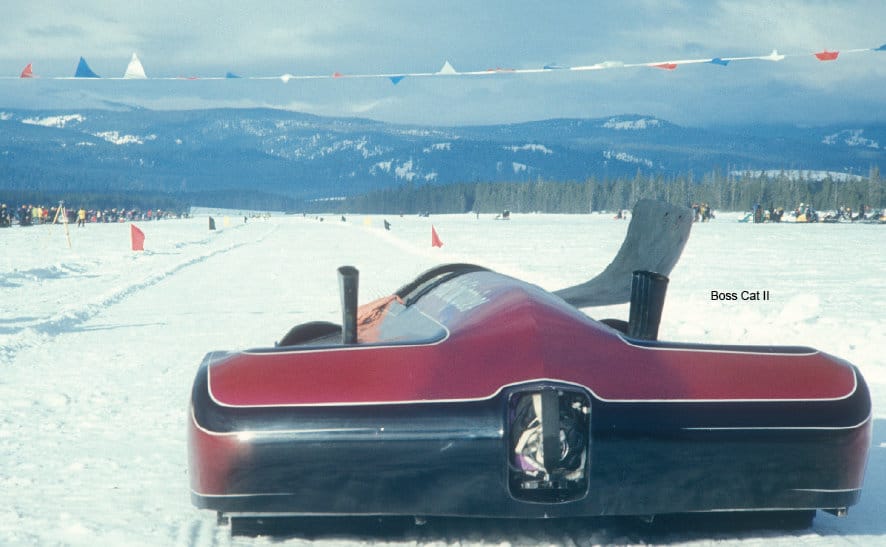
Arctic Cat unveiled the Boss Cat III, which was patterned off the Ski-Doo X-4R. It was Arctic’s answer to the complaints that Cat could not build a speed sled powered by snowmobile engines. This Boss was only 18ft long and had four 650cc triple/triple engines for a total of 400hp. Paul Eggebraaten from Team Arctic was the driver and on his first run it hit 118 mph. The second run was only 69 mph as the sled suffered clutch problems.
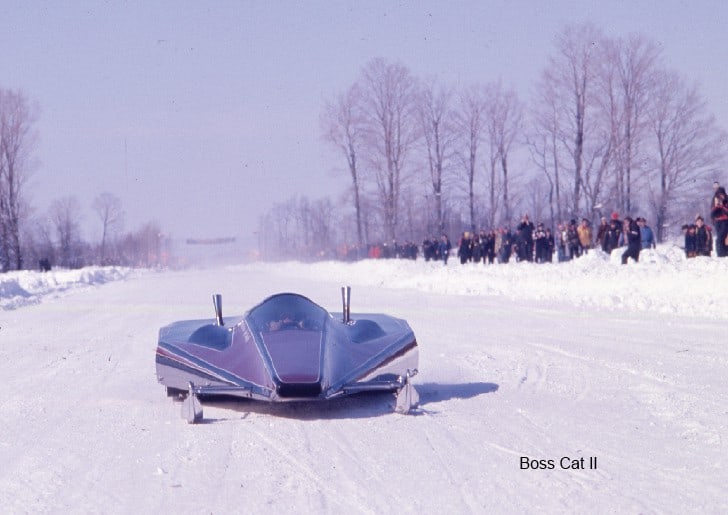
The defending champ, Yvon Duhamel brought out the X-2R record holder sled from ‘72 and ran back-to-back runs down the 1.5 mile course for an average speed of 126.73mph. Fast, but fast enough to break his ‘72 record.
The final chapter of the Factory Speed run sleds was written in West Yellowstone where it all began back in 1967. Now 6 years later the sleds were a far cry from those antiquated sleds of yesteryear. Charlie Lofton from Team Arctic raced the Boss Cat II down the airport strip at 128 mph, and the Boss Cat III reached 105mph. Politics which seems to plague most of life again played its hand here as the USSA sanctioning body didn’t recognize the speed as it was not the offical sanctioning body. The speed machine era was over for now. The problem with the speed run sleds was that there was not enough time to troubleshoot them after they were built. Huge amount of manhours went into the development and fabrication of these dream machines but it seems there was never enough time to debugg these sleds prior to bringing them out to the events. For many it became an exercise in frustration and the consequences when a part failed when travelling over 120 mph was disastorous. The Arctic speed sleds would make appearances at special events untill they were sold to collectors. The Polaris sleds still exist and the Ski-Doo sleds are owned by private collectors.
New speed sleds would appear in the 80’s that would once again capture the imagination of snowmobilers and the people that would create them. This time the independents would build speed sleds that would eat the Boss Cat behomeths alive. But that story will have to wait for now. Stay tuned!
By Hal Armstrong
You can follow Hal’s regular contributions to SnowTech Magazine in our “Vintage Rider” section. Subscribe here.
Follow Hal Armstrong on Facebook @sledtimemachines
Photos from the Archives of SnowTech Magazine







No comments so far.
Be first to leave comment below.